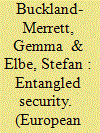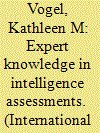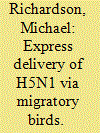|
|
|
Sort Order |
|
|
|
Items / Page
|
|
|
|
|
|
|
| Srl | Item |
| 1 |
ID:
165328


|
|
|
|
|
| Summary/Abstract |
This article advances a new account of security as an intensely relational and ontologically entangled phenomenon that does not exist prior to, nor independently of, its intra-action with other phenomena and agencies. Security's ‘entanglement’ is demonstrated through an analysis of the protracted security concerns engendered by ‘dangerous’ scientific experiments performed with lethal H5N1 flu viruses. Utilising methodological approaches recently developed in the field of Science and Technology Studies (STS), the article explicates the intensely ‘co-productive’ dynamics at play between security and science in those experiments, and which ultimately reveal security to be a deeply relational phenomenon continuously emerging out of its engagement with other agencies. Recovering this deeper ontological entanglement, the article argues, necessitates a different approach to the study of security that does not commence by fixing the meaning and boundaries of security in advance. Rather, such an approach needs to analyse the diverse sites, dynamics, and processes through which security and insecurity come to intra-actively materialise in international relations. It also demands a fundamental reconsideration of many of the discipline's most prominent security theories. They are not merely conceptual tools for studying security, but crucial participants in its intra-active materialisation.
|
|
|
|
|
|
|
|
|
|
|
|
|
|
|
|
| 2 |
ID:
127889


|
|
|
|
|
| Publication |
2013.
|
| Summary/Abstract |
In 2011, scientists in the Netherlands and Japan announced that they had created a modified variant of the H5N1 avian influenza virus that was transmissible via aerosol, raising fears of a new, highly lethal H5N1 virus that could cause a deadly global pandemic. Soon, government officials and the media were raising alarms about the wisdom of publishing such experimental methods and results in the open scientific literature. Their concerns sparked a large public controversy about the H5N1 experiments and their potential publication. In the midst of this controversy, U.S. intelligence analysts began assessing the potential security implications of the H5N1 manuscripts, including whether a terrorist, criminal, or state could easily replicate these experiments and create mutated viruses for bioweapons use. An in-depth look at this controversy reveals that, first, U.S. intelligence analysts do not have adequate social and material resources to identify and evaluate the tacit knowledge, or know-how, that underpins dual-use experiments such as those in the H5N1 case. Second, they lack dedicated structures and methods to understand the politics that characterize the use of technical expertise in such controversial biosecurity issues. Third, they require new types, structures, and uses of expert knowledge to enable them to make more informed and balanced assessments of biosecurity threats.
|
|
|
|
|
|
|
|
|
|
|
|
|
|
|
|
| 3 |
ID:
069054


|
|
|
| 4 |
ID:
097322


|
|
|
| 5 |
ID:
126143


|
|
|
|
|
| Publication |
2012.
|
| Summary/Abstract |
The dual-use dilemma in the life sciences-that illicit applications draw on the same science and technology base as legitimate applications-makes it inherently difficult to control one without inhibiting the other. Since before the September 11 attacks, the science and security communities in the United States have struggled to develop governance processes that can simultaneously minimize the risk of misuse of the life sciences, promote their beneficial applications, and protect the public trust. What has become clear over that time is that while procedural steps can be specified for assessing and managing dual-use risks in the review of research proposals, oversight of ongoing research, and communication of research results, the actions or decisions to be taken at each of these steps to mitigate dual-use risk defy codification. Yet the stakes are too high to do nothing, or to be seen as doing nothing. The U.S. government should therefore adopt an oversight framework largely along the lines recommended by the National Science Advisory Board for Biosecurity almost 5 years ago-one that builds on existing processes, can gain buy-in from the scientific community, and can be implemented at modest cost (both direct and opportunity), while providing assurance that a considered and independent examination of dual-use risks is being applied. Without extraordinary visibility into the actions of those who would misuse biology, it may be impossible to know how well such an oversight system will actually succeed at mitigating misuse. But maintaining the public trust will require a system to be established in which reasonably foreseeable dual-use consequences of life science research are anticipated, evaluated, and addressed.
|
|
|
|
|
|
|
|
|
|
|
|
|
|
|
|
|
|
|
|
|